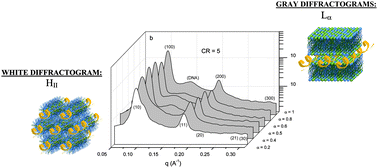Gene vectors based on DOEPC/DOPE mixed cationic liposomes: a physicochemical study
Abstract
A double approach, experimental and theoretical, has been followed to characterize from a physicochemical standpoint the compaction process of

Maintenance work is planned for Wednesday 1st May 2024 from 9:00am to 11:00am (BST).
During this time, the performance of our website may be affected - searches may run slowly and some pages may be temporarily unavailable. If this happens, please try refreshing your web browser or try waiting two to three minutes before trying again.
We apologise for any inconvenience this might cause and thank you for your patience.
* Corresponding authors
a
Grupo de Química Coloidal y Supramolecular, Departamento de Química Física I, Facultad de Ciencias Químicas, Universidad Complutense de Madrid, Madrid, Spain
E-mail:
junquera@quim.ucm.es
Web: http://www.ucm.es/info/coloidal/index.html
Fax: +34 913944135
Tel: +34 913944131
b Department of Polymer Chemistry, Zernike Institute for Advanced Materials, University of Groningen, Nijenborgh 4, Groningen, The Netherlands
c Instituto de Estructura de la Materia, CSIC, Serrano 121, Madrid, Spain
d Centro de Investigaciones Biológicas, CSIC, Ramiro de Maeztu 9, Madrid, Spain
e Departamento de Física, Escuela Politécnica Superior de Linares, Universidad de Jaén, Linares, Jaén, Spain
f Grupo de Física de Fluidos y Biocoloides, Departamento de Física Aplicada, Facultad de Ciencias, Universidad de Granada, Granada, Spain
A double approach, experimental and theoretical, has been followed to characterize from a physicochemical standpoint the compaction process of

 Please wait while we load your content...
Something went wrong. Try again?
Please wait while we load your content...
Something went wrong. Try again?
M. Muñoz-Úbeda, A. Rodríguez-Pulido, A. Nogales, O. Llorca, M. Quesada-Pérez, A. Martín-Molina, E. Aicart and E. Junquera, Soft Matter, 2011, 7, 5991 DOI: 10.1039/C1SM05352C
To request permission to reproduce material from this article, please go to the Copyright Clearance Center request page.
If you are an author contributing to an RSC publication, you do not need to request permission provided correct acknowledgement is given.
If you are the author of this article, you do not need to request permission to reproduce figures and diagrams provided correct acknowledgement is given. If you want to reproduce the whole article in a third-party publication (excluding your thesis/dissertation for which permission is not required) please go to the Copyright Clearance Center request page.
Read more about how to correctly acknowledge RSC content.
 Fetching data from CrossRef.
Fetching data from CrossRef.
This may take some time to load.
Loading related content
